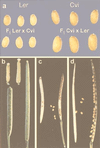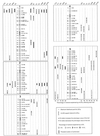Natural allelic variation at seed size loci in relation to other life history traits of Arabidopsis thaliana
- PMID: 10200327
- PMCID: PMC16397
- DOI: 10.1073/pnas.96.8.4710
Natural allelic variation at seed size loci in relation to other life history traits of Arabidopsis thaliana
Abstract
We have analyzed two Arabidopsis strains differing in the mean seed size and seed number they produced. The accession Cape Verde Islands (Cvi) yielded on average about 40% fewer seeds than the laboratory strain Landsberg erecta (Ler), but Cvi seeds were almost twice as heavy. Maternal and nonmaternal genetic factors were involved in the seed size variation, and interactions between both types of factors presumably occurred. The Ler/Cvi seed size difference increased through seed development from ovule maturation until seed desiccation, suggesting that multiple processes of seed development were affected. In addition, it involved changes in the final cell number and cell size of the seed coat and the embryo. Cell number variation was controlled mainly by maternal factors, whereas nonmaternal allelic variation mostly affected cell size. By using a recombinant inbred line population derived from Ler and Cvi, we mapped quantitative trait loci (QTLs) affecting 12 life history traits related to seed size, fruit size, seed number, and plant resources. Five of the seed size QTLs colocated with QTLs for other traits, suggesting that they control seed size via maternal components affecting ovule number and/or carpel development, ovule development, or reproductive resource allocation in the mother plant. The six remaining putative seed size QTLs did not show a significant effect on any other trait, suggesting that this allelic variation may be involved specifically in seed development processes.
Figures





References
-
- Harper J L, Loveli P H, Moore K G. Annu Rev Ecol Syst. 1998;1:327–356.
-
- Silvertown J. Trends Ecol Evol. 1989;4:24–26. - PubMed
-
- Westoby M, Jurado E, Leishman M. Trends Ecol Evol. 1992;7:368–372. - PubMed
-
- Krannitz P G, Aarssen L W, Dow J M. Am J Bot. 1991;78:446–450.
-
- Stanton M. Ecology. 1984;65:1105–1112.
Publication types
MeSH terms
Substances
LinkOut - more resources
Full Text Sources
Other Literature Sources

